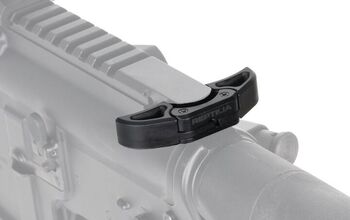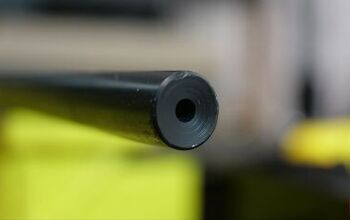Fudd Friday: Buying A Gun For Black Bear Hunting

It’s spring, and across much of North America, that means it’s hunting season for black bears. If you’re an experienced bear hunter, you probably know what works best for you and your hunting situation, but if you’re just starting out, here are some recommendations to consider if you’re wondering what gun you should get.
Taking care of bears @ TFB:
Bears aren’t bulletproof
The reality is that anyone who’s seen a lot of black bears shot will tell you black bears are not that hard to kill if you shoot accurately, and if you shoot poorly, caliber will only compensate so much. I’ve talked to my share of black bear guides, including my neighbors and friends I’ve worked with for years, and I only ever heard one story of someone who lost a bear from the wrong firearm choice—and in that case, it was a matter of using buckshot in a 12-gauge instead of a slug.
The TL/DR is that any rifle you use for deer hunting will work for most black bears. If you’re hunting truly large black bears, then you will definitely want a harder-hitting weapon, but for the 150-400 pound bears that most people are hunting, especially in the spring, a deer gun is fine.
Black bears can get much larger than 400 pounds; the largest ever killed was shot close to my home, in 1972. That monster weighed just over 900 pounds field-dressed. But even a bear that size is about the size of a large moose, and hunters kill thousands of moose across North America every season with .30-30s, .243s and other light-recoiling rifles. The last bear I personally shot was with a .30-30 using Winchester PowerMax Bonded hollow-points, which few people would recommend for bears. I had a perfect pass-through from the expanded bullet, and the bear didn’t make it more than 20 yards on its last legs. As always, shot placement is key.
Big bullets vs. fast bullets
But if you’re going to go out and buy a new gun for bear hunting anyway, here’s the basic question: Do you want big bullets, or do you want fast bullets?
Many bear hunters believe a heavy, big-bore bullet from something like a .45-70 or .35 Remington is the answer, or even shotgun slugs and there certainly have been a lot of bears killed with these rounds, especially when hunting over bait. When I started bear hunting, the most powerful weapon I could afford was my old Winchester 1300 duck gun and it had no problem filling tags. My original theory was that even if I didn’t get an exit hole, the massive 12-gauge slugs would still leave a blood trail. As it turned out, the slugs knocked the bears right over in their tracks, and no tracking was needed.
Other hunters put more priority on a bullet’s speed over its weight, saying the hydrostatic shock wave of a high-velocity bullet shuts a bear’s central nervous system down quickly. They believe this means less likelihood a bear will run off and require a long tracking job, when compared to an animal shot by a slower bullet through the lungs or circulatory system.
Based on my own observations and talking to guides, I believe high-velocity rounds like .308, .270, or .30-06, not to mention the many newer, faster magnums and short magnums and long-range cartridges, will all do the job at least as well as slower-speed rounds. The only reason not to use them is, if you plan to eat the bear, there is the question of meat loss. A slower round means less blood-shot meat, generally speaking.
So, if I was going to hunt over bait, as is the case with most bear hunting, I would be fine with either choice. If I was hunting long-range spot-and-stalk style, then it’s no question—I’d want the high-velocity rounds, ideally something that retained lots of energy out to 300 yards.
What action works best?
Bolt-action, pump-action, semi-auto, lever-action, single-shots—they all work, although a quick follow-up shot is always nice, if it can save you a tracking job. If you’re hunting exclusively at long range, you’re probably going to go with a bolt gun, though. At close range, I think it’s hard to beat a lever gun. They shoot almost as fast as a pump gun or semi-auto, but they don’t make as much noise in the stand—the noise of a safety carelessly flicking to the OFF position can be audible in the stillness of the woods. It’s unlikely you’ll scare off an animal this way, but it’s the sort of thing you worry about while you sit and watch. With a lever gun, you can cock the hammer much more quietly as you prepare to shoot. Noise and scent are both major reasons hunters don’t see mature bears from their stands, so this is worth considering.
A break-action single shot with a hammer is just as quiet, and you can load it much more quietly than the lever gun—you just don’t get a fast follow-up shot.
What really matters
After hunting bears close-range over bait in east coast swamps, and at long distances on New Brunswick’s Gagetown army base, I now believe the most important factor isn’t whether your gun is a high-powered magnum or a classic lever-action deer rifle—what really matters is your optics.
If you’re going to be hunting over bait, you will often be sitting at last light, or in the stand at the crack of dawn. The forest will be dark, and you need to be able to see what you’re shooting at. It’s not as easy to pick out your aiming point on a black bear as it is a deer, especially in low light conditions—their fur turns into a big black blob. You can shoot a bear with iron sights at close range, easily, but especially at last light, a scope with good light-gathering capabilities will pay off.
When you’re hunting at long range, you should be glassing with a spotting scope or binoculars, but when it’s time to take the shot, again, you want optics that you can trust.
This is especially true in spring hunting, when you need to be careful not to shoot a sow accompanied by cubs. Good optics may show you a baby bear lurking nearby, something you might have missed otherwise.
With this in mind, your bear rifle (or shotgun) should be capable of mounting a good scope that reflects your hunting conditions. A low-powered optic is ideal for the woods; even a 3x scope might be too much at close range. At long range, a higher-powered scope with good clarity is what you want. There are scopes that offer good performance at both close- and long-range; do your homework, and you should find something that works.











![[SHOT 2025] The CarbonMax From Wraithworks](https://cdn-fastly.thefirearmblog.com/media/2025/01/21/11501/shot-2025-the-carbonmax-from-wraithworks.jpg?size=350x220)


![[SHOT 2025] Magna Lens Relieves Eye and Ear Protection Pain](https://cdn-fastly.thefirearmblog.com/media/2025/01/27/22151/post.jpg?size=350x220)








![[SHOT 2025] Winchester Optics Launch New Thermal Optics Line](https://cdn-fastly.thefirearmblog.com/media/2025/01/23/15221/shot-2025-winchester-optics-launch-new-thermal-optics-line.jpg?size=350x220)




Comments
Join the conversation
SCAR17 or AR10 type rifle, is my bear gun of choice.